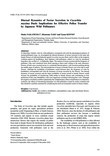Diurnal Dynamics of Nectar Secretion in Cucurbita maxima Duch: Implications for Effective Pollen Transfer by Japanese Wild Pollinators
Japan Agricultural Research Quarterly
| ISSN | 00213551 |
|---|---|
| NII recode ID (NCID) | AA0068709X |

Full text
jarq55-4_323-331.pdf935.54 KB
To determine whether visits by wild pollinators correspond well with the physiological patterns of animal-pollinated crops, we investigated the diurnal dynamics of nectar secretion in the male and female flowers of cultivated kabocha squash Cucurbita maxima Duch, and its effect on the temporal visitation pattern by bumblebees, their Japanese wild pollinators, relative to visits by introduced honeybees Apis mellifera L. in Hokkaido, Japan. The amount of nectar secreted and the frequency of pollinator visits were monitored from floral opening at dawn until wilting in the early afternoon. Flowers of both sexes secreted nectar in a unimodal diurnal pattern, with secretion peaking during the middle stage of anthesis. The total production of nectar in female flowers was twice that in male flowers. Although the availability of pollinators varied between days, the frequency of visits by bumblebees corresponded well with the dynamics of nectar secretion by the flowers. The diurnal dynamics of nectar secretion and the large availability of nectar reward in female flowers would increase the probability of transferring viable pollen to female flowers and contributing to fruit production of this crop. Bumblebee visits were negatively correlated with honeybee visits. Although this negative correlation could be explained by the complementary effects of pollinators or competitive exclusion, the effects of introducing honeybees on wild pollinators cannot be easily evaluated and thus should be carefully examined by considering the local environmental context in future studies.
| Date of issued | |
|---|---|
| Creator | Shoko NAKAMURA Hisatomo TAKI Yasuo KONNO |
| Subject | Apis mellifera bumblebees entomophilous crops male and female flowers pollination services |
| Publisher | Japan International Research Center for Agricultural Sciences |
| Received Date | 2020-09-25 |
| Accepted Date | 2020-12-14 |
| Volume | 55 |
| Issue | 4 |
| spage | 323 |
| epage | 331 |
| DOI | 10.6090/jarq.55.323 |
| Language | eng |
